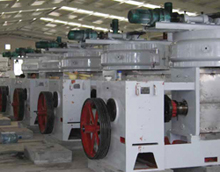- Choose professional Small Sunflower Seed Oil Refinery Line
- Professionally Designed Mini Oil Mill for Home Use
- Is Small Oil Production Line Worth for Investment?
- How to Build Small Edible Oil Production Line?
- Small Oil Mill Plant for Daily Requirement
- Small Edible Oil Refinery Plant Cost Can Be Reduced Relatively
- How to Extract Palm Oil from Palm Fruit-Oil Mill Plant
- start oil extraction factory
coconut oil milling process
Coconut Oil Milling Process
Coconut oil milling process or technologies are classified into two major types: the dry and the wet processes. The coconut oil processing starts with copra as the raw material is termed as the dry process, while the method that uses fresh coconuts as starting material is generally called the wet process.

Dry processing of meat for coconut oil milling process involves the conversion of coconut meat into copra prior to expelling and refining. This process is however done off-farm, in an oil mill. At the mill, the copra undergoes the following steps:
- Cleaning: Copra is cleaned of metals, dirt and other foreign matter
- Crushing: Copra is broken into fine particle sizes
- Cooking/Conditioning: The crushed copra that has about 5-6 percent moisture is passed through a steam-heated cooker. This brings the temperature of the copra to the conditioning temperature of about 104oC (220oF). At the conditioner, the copra is maintained at about 104-110oC (220-230oF) for about 30 minutes to insure uniform heat penetration before oil extraction. Moderately high temperature facilitates the expelling action. Oil is able to flow out more easily due to decrease in viscosity proteins and other substances present in the copra. Heating dries and shrinks these substances. Moisture content of copra is about 3 percent when it leaves the conditioner.
- Oil extraction: In the expeller, the milled copra is subjected to high-pressure oil extraction. The temperature of the oil should be kept at about 93-102oC (200-215oF) to produce light coloured oil and effect good extraction.
- Screening: The oil extracted in the expeller flows into the screening tanks to remove the entrained foots from the oil. While travelling across the screen, oil is drained out of the foots. The filtered oil flows into a surge tank from where it is finally pumped to the coconut oil storage tank.
- Filtration: The oil is passed through a plate and frame filter press to further remove the solids in the oil. Two filter presses are provided - one on duty while the other is being cleaned and dressed. Maximum filtering pressures reach about 60 psi. The filtered oil flows into a surge tank from where it is finally pumped to the coconut oil storage tank.
Coconut oil produced from good quality copra is clear, low in fatty acid and has good coconut aroma. However crude coconut oil from bad quality copra is dark; turbid; high in free fatty acids (FFA), phosphatides and gums; has an unpleasant odour. To render this oil edible, it has to undergo a refining process. Refining consists of neutralization, bleaching and deodorizing.
Information for Cocout Oil
Coconut oil is an edible oil extracted from the kernel or meat of matured coconuts harvested from the coconut palm (Cocos nucifera). Throughout the tropical world, it has provided the primary source of fat in the diets of millions of people for generations. It has various applications in food, medicine, and industry.
Copra, the dried kernel is the chief commercial product from coconut, which is mainly used for oil extraction. Copra normally has an oil content varying from 65 to 72 per cent. The quality of an ISO certified coconut oil is related to the quality of copra we use.
The most commonly coconut oil is refined, bleached and deodorised coconut oil or RBD coconut oil, which is produced from dry coconut meat (copra). RBD coconut oil is produced from copra. Copra is made by drying coconut in the sun, smoking and heating it. During the production process, chemicals are used and the oils are heated to high temperatures where they can form of a certain percentage of trans-fatty acids, which contribute to arteriosclerosis, heart disease and diabetes. Because this coconut oil is produced with high temperatures and chemicals, its taste becomes bland with a composition of about 3-4% of Lauric Acid. RBD Coconut oil is widely used in the Far East as cheap cooking oil.

 Français
Français Русский
Русский Español
Español